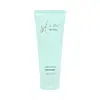What's inside
What's inside
 Key Ingredients
Key Ingredients

 Benefits
Benefits

 Concerns
Concerns

 Ingredients Side-by-side
Ingredients Side-by-side

Water
Skin ConditioningGlycerin
HumectantDimethicone
EmollientOctyldodecanol
EmollientPhenoxyethanol
PreservativePolyacrylamide
Acrylates/C10-30 Alkyl Acrylate Crosspolymer
Emulsion StabilisingC13-14 Isoparaffin
EmollientSilica
AbrasiveCetearyl Olivate
Sorbitan Olivate
EmulsifyingSodium Hydroxide
BufferingPotassium Hydroxide
BufferingDimethicone/Vinyl Dimethicone Crosspolymer
Skin ConditioningLaureth-7
EmulsifyingSalicylic Acid
MaskingEthylhexylglycerin
Skin ConditioningParfum
MaskingDisodium EDTA
Glycyrrhiza Uralensis Root Extract
Skin ConditioningSchisandra Chinensis Fruit Extract
Skin ConditioningPaeonia Lactiflora Root Extract
Skin Conditioning1,2-Hexanediol
Skin ConditioningHippophae Rhamnoides Fruit Extract
Skin ConditioningSalix Alba Bark Extract
AstringentWater, Glycerin, Dimethicone, Octyldodecanol, Phenoxyethanol, Polyacrylamide, Acrylates/C10-30 Alkyl Acrylate Crosspolymer, C13-14 Isoparaffin, Silica, Cetearyl Olivate, Sorbitan Olivate, Sodium Hydroxide, Potassium Hydroxide, Dimethicone/Vinyl Dimethicone Crosspolymer, Laureth-7, Salicylic Acid, Ethylhexylglycerin, Parfum, Disodium EDTA, Glycyrrhiza Uralensis Root Extract, Schisandra Chinensis Fruit Extract, Paeonia Lactiflora Root Extract, 1,2-Hexanediol, Hippophae Rhamnoides Fruit Extract, Salix Alba Bark Extract
Water
Skin ConditioningEthylhexyl Palmitate
EmollientPropylene Glycol
HumectantGlycerin
HumectantDimethicone
EmollientCetearyl Alcohol
EmollientGlyceryl Stearate
EmollientPEG-100 Stearate
Butylene Glycol
HumectantPropanediol
SolventHydroxyacetophenone
AntioxidantCarbomer
Emulsion StabilisingTriethanolamine
BufferingCetearyl Glucoside
EmulsifyingSorbitan Stearate
EmulsifyingSodium Acrylate/Sodium Acryloyldimethyl Taurate Copolymer
Emulsion StabilisingSodium Acrylates Copolymer
Pentylene Glycol
Skin ConditioningAllantoin
Skin ConditioningGalla Rhois Gallnut Extract
AntimicrobialIsohexadecane
EmollientAloe Barbadensis Leaf Juice
Skin ConditioningGentiana Scabra Root Extract
Skin ConditioningXanthan Gum
EmulsifyingCaprylhydroxamic Acid
Lecithin
EmollientCaprylic/Capric Triglyceride
MaskingPolysorbate 80
EmulsifyingDisodium EDTA
Niacinamide
SmoothingCedrus Atlantica Bark Oil
MaskingSorbitan Oleate
EmulsifyingMelaleuca Alternifolia Leaf Oil
AntioxidantPelargonium Graveolens Oil
MaskingCitrus Paradisi Peel Oil
MaskingPanthenol
Skin ConditioningEctoin
Skin ConditioningPhenoxyethanol
PreservativeTrehalose
HumectantGlyceryl Glucoside
HumectantDipotassium Glycyrrhizate
HumectantRheum Palmatum Root Extract
AstringentScutellaria Baicalensis Root Extract
AstringentPhellodendron Amurense Bark Extract
Skin ConditioningSalvia Miltiorrhiza Root Extract
Skin ConditioningEthylhexylglycerin
Skin ConditioningMadecassoside
AntioxidantAsiaticoside
AntioxidantAsiatic Acid
Skin ConditioningMadecassic Acid
Skin ConditioningCaprylyl Glycol
EmollientGlyceryl Caprylate
EmollientStephania Tetrandra Root Extract
Skin ConditioningZinc PCA
HumectantCI 19140
Cosmetic ColorantCI 17200
Cosmetic ColorantWater, Ethylhexyl Palmitate, Propylene Glycol, Glycerin, Dimethicone, Cetearyl Alcohol, Glyceryl Stearate, PEG-100 Stearate, Butylene Glycol, Propanediol, Hydroxyacetophenone, Carbomer, Triethanolamine, Cetearyl Glucoside, Sorbitan Stearate, Sodium Acrylate/Sodium Acryloyldimethyl Taurate Copolymer, Sodium Acrylates Copolymer, Pentylene Glycol, Allantoin, Galla Rhois Gallnut Extract, Isohexadecane, Aloe Barbadensis Leaf Juice, Gentiana Scabra Root Extract, Xanthan Gum, Caprylhydroxamic Acid, Lecithin, Caprylic/Capric Triglyceride, Polysorbate 80, Disodium EDTA, Niacinamide, Cedrus Atlantica Bark Oil, Sorbitan Oleate, Melaleuca Alternifolia Leaf Oil, Pelargonium Graveolens Oil, Citrus Paradisi Peel Oil, Panthenol, Ectoin, Phenoxyethanol, Trehalose, Glyceryl Glucoside, Dipotassium Glycyrrhizate, Rheum Palmatum Root Extract, Scutellaria Baicalensis Root Extract, Phellodendron Amurense Bark Extract, Salvia Miltiorrhiza Root Extract, Ethylhexylglycerin, Madecassoside, Asiaticoside, Asiatic Acid, Madecassic Acid, Caprylyl Glycol, Glyceryl Caprylate, Stephania Tetrandra Root Extract, Zinc PCA, CI 19140, CI 17200
Ingredients Explained
These ingredients are found in both products.
Ingredients higher up in an ingredient list are typically present in a larger amount.
Dimethicone is a type of synthetic silicone created from natural materials such as quartz.
What it does:
Dimethicone comes in different viscosities:
Depending on the viscosity, dimethicone has different properties.
Ingredients lists don't always show which type is used, so we recommend reaching out to the brand if you have questions about the viscosity.
This ingredient is unlikely to cause irritation because it does not get absorbed into skin. However, people with silicone allergies should be careful about using this ingredient.
Note: Dimethicone may contribute to pilling. This is because it is not oil or water soluble, so pilling may occur when layered with products. When mixed with heavy oils in a formula, the outcome is also quite greasy.
Learn more about DimethiconeDisodium EDTA plays a role in making products more stable by aiding other preservatives.
It is a chelating agent, meaning it neutralizes metal ions that may be found in a product.
Disodium EDTA is a salt of edetic acid and is found to be safe in cosmetic ingredients.
Learn more about Disodium EDTAEthylhexylglycerin (we can't pronounce this either) is commonly used as a preservative and skin softener. It is derived from glyceryl.
You might see Ethylhexylglycerin often paired with other preservatives such as phenoxyethanol. Ethylhexylglycerin has been found to increase the effectiveness of these other preservatives.
Glycerin is already naturally found in your skin. It helps moisturize and protect your skin.
A study from 2016 found glycerin to be more effective as a humectant than AHAs and hyaluronic acid.
As a humectant, it helps the skin stay hydrated by pulling moisture to your skin. The low molecular weight of glycerin allows it to pull moisture into the deeper layers of your skin.
Hydrated skin improves your skin barrier; Your skin barrier helps protect against irritants and bacteria.
Glycerin has also been found to have antimicrobial and antiviral properties. Due to these properties, glycerin is often used in wound and burn treatments.
In cosmetics, glycerin is usually derived from plants such as soybean or palm. However, it can also be sourced from animals, such as tallow or animal fat.
This ingredient is organic, colorless, odorless, and non-toxic.
Glycerin is the name for this ingredient in American English. British English uses Glycerol/Glycerine.
Learn more about GlycerinPhenoxyethanol is a preservative that has germicide, antimicrobial, and aromatic properties. Studies show that phenoxyethanol can prevent microbial growth. By itself, it has a scent that is similar to that of a rose.
It's often used in formulations along with Caprylyl Glycol to preserve the shelf life of products.
Water. It's the most common cosmetic ingredient of all. You'll usually see it at the top of ingredient lists, meaning that it makes up the largest part of the product.
So why is it so popular? Water most often acts as a solvent - this means that it helps dissolve other ingredients into the formulation.
You'll also recognize water as that liquid we all need to stay alive. If you see this, drink a glass of water. Stay hydrated!
Learn more about Water